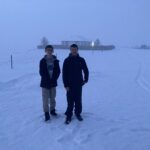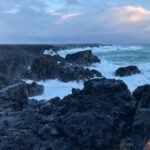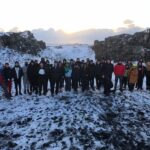MCS Geography: Iceland Fieldtrip blog
Day 1 – Weds 15th Feb: MCS – Hotel Vatnsholt, SW Iceland
An early start this morning – 4.30am outside the school gates! Feelings of eagerness, anticipation (and slight angst among the teachers) could be felt as we waited for the coach, which arrived 10 minutes behind schedule. However, a smooth journey got us to Heathrow promptly and we navigated check in and security without any mishaps. Pupils enjoyed airport breakfast while others did some plane-spotting. Our tour guide, Stephen, met us and introduced himself before we boarded the flight.
On arriving in Iceland, we were greeted with heavy snowfall and sharp, chilling winds – a true baptism to Icelandic conditions. Waiting for us was our rather stern and bus-proud driver, Bernstein, who oversaw a strict and well-rehearsed luggage-packing-protocol, before delivering the ‘ground rules of transit on Bernstein’s bus’. From Keflavik airport we drove across the lava fields of the south-west to the ‘bridge between the continents’ and walked over the fissure that has opened as the North American and Eurasian tectonic plates have split apart. Some snowball fights broke out as we clambered down into the fault line.
Our next stop was Brimketill, an extraordinary geological feature on the coast near Staðarberg. Here the lava rock of the coastline has been rounded into what looks like a big man-made bath tub due to the constant beating of the Atlantic waves. A raised metal walkway led us to a coastal viewing platform where enormous waves crashed beneath us and covered us in spray. An unfortunate group of year 10 pupils had an early shower. Before re-boarding the coach Bernstein conducted a thorough boot inspection to prevent any sand being deposited back on board.
From here we had a long drive to Hotel Vatnsholt. En route Stephen described recent volcanic activity in the area and pointed out new lava flows which had melted the thick snow from sections of some hillsides. We arrived at Hotel Vatnsholt at 7.30pm, all feeling very hungry and worn out from a long day of travel. Rooms were allocated before we shared spaghetti bolognese followed by ice cream for our evening meal. We invited Bernstein to join us, hoping to mellow him for the coming days. Before bed, pupils enjoyed the games room, some
TV or followed the Swans in their 2-1 win against Blackpool.
Day 2 – Thurs 16th Feb: the Secret Lagoon, Gulfoss, Geysir, Thingvellir National Park.
We set out for the Secret Lagoon first thing after a breakfast of cereal, waffles and juices. We spent an hour bathing in the geothermally heated waters. Parts of it were very, very warm so we had to pick our bathing spots carefully. Nearly everyone tried some ‘snow bathing’ too for the true Icelandic experience; getting really, really cold before submerging themselves in the warm water.
Next we drove to Gulfoss, a huge waterfall where thousands of litres tumble over two-tiers into a narrow canyon. In the past British investors planned to divert the river for energy production but were unsuccessful after a protest by a local farmer’s daughter, Sigridur Tomasdottir, who walked to Reykjavík bare foot to draw attention to the issue. Also en route was a pool used to drown suspected witches in
A few miles further we stopped at Geysir, another geothermal area with bubbling springs and geysers. We walked a short distance, past a number of steaming fumaroles that bubbled away with a smell of rotten eggs. We then reached Strokkur, the most impressive geyser in the area which constantly bubbles away then blasts water 20m in the air every 5 minutes or so. We saw a series of four or five steam eruptions, each more impressive than the last. Pupils then had time to buy souvenirs and extra food in the shopping area nearby.
Our last visit of the day was to Thingvellir National Park. We stopped at at a number of viewing platforms with impressive panoramas over the rift valley that runs south-west to north-East through Iceland. We then walked about a mile through the Rift Valley alongside the edge of the North American Plate which towered to our right hand side. Looking east we could see braided streams running into Lake Thingvellirvatn and volcanoes framing the horizon. En route Stephen stopped us at Logberg ‘the law rock’. Here Iceland’s Viking leaders formed the world’s first democratic parliament and would meet annually to recite existing laws and resolve judicial matters. We also stopped along the way at a footbridge to admire the gurgling water below. But this was the Drekkingarhylur (Drowning Pool) a place where, between 1602 and 1750, at least 18 women were executed for suspected witchcraft.
Evening meal of bbq chicken, rice and chips followed by apple crumble.
Day 3 – Fri 17th Feb: Eyjafjallajokull viewpoint, Skogafoss, Solheimajokull, Dyrholaey, Gljufrabui and Seljalandsfoss, Urriðafoss
Everyone was up promptly for breakfast at 7.00am with lots to squeeze into today’s itinerary. We left Hotel Vatnsholt by 8.00am and drive towards a stunning ombré sunrise of blues, greens and pinks. Our first stop along the route was a viewing area out across the volcanic mountains, the most important being Eyjafjallajokull, the volcano which erupted in 2010 bringing European and American air travel to a halt due to the huge ash cloud it produced.
Further up the road we stopped at Skogafoss, a 60m waterfall pouring over a fossilised sea cliff. Tectonic activity has uplifted the surrounding landscape draining the sea and leaving the cliffs standing inland, a few miles from the present day coastline. Fossilised sea stacks could also be seen in the farmland we passed. At Skogafoss we climbed a long staircase to a viewing platform which looked down over the falls and out towards the coast. We then climbed down. It was very icy and treacherous and few of us had small tumbles which brought a few laughs. At the bottom we walked into the spray zone created as water pours down into the plunge pool beneath the falls. Huge icicles hung from the rocks and ground was covered by ice that had frozen in spherical, bubble shapes.
From here we travelled to Solheimajokull glacier where we were kitted out with harnesses, ice axes and crampons. We walked the initial mile along an undulating, icy path alongside the glacial lake. Our adventure guides pointed out that the glacier has retreated by around 50 meters per year since the mid 1990s owing to climate change, leaving the large lagoon alongside us. As we reached the snout of the glacier we attached our crampons and started the steep ascent up and over the solid glacial ice. We were warned to remain in single file as the heavy snowfall of recent days could have hidden deep holes and crevasses under thin bridges of snow. We passed deep chasms and walked through a more recent crevasse before reaching the plateau on top of the glacier after an hour and a half of hiking. On reaching the plateau pupils were allowed switch their ice axes to ‘attack mode’ and spent the next 10 minutes chipping, hacking and chiseling away at the ice. On the return leg we were taken right down the edge of ablation (melt) zone where huge blocks of ice shear away from the glacier. We had to proceed with extreme care; our guide taking tiny steps and prodding the snow, which was thigh deep in places, with his ice axe to check the hidden ice for strength and stability. We followed cautiously, reaching a great vantage point looking down over the crevasses and blocks of ice and lake beyond that. A gentle reminder of the hidden dangers occurred as we turned to leave. Stepping on a seemingly frozen pool one pupil ended up knee deep in icy cold water as it collapsed beneath them. We hiked back down to the coach to eat our packed lunch.
Next stop was Dyrholaey, a 120m high coastal promotory giving excellent views over the volcanic black sand beaches of Iceland’s south coast and a textbook example of sea caves, arches, stacks and stumps. The waves crashing against the coastline here have travelled right across the Atlantic and hit the coast which such force the cliffs seem to vibrate and large columns of spray are funneled up through a nearby blowhole.
From here we drove to Gljufrabui; the canyon dweller. Hidden behind a tight rock face, the group had to take turns to carefully plot their route over the stepping stones, to squeeze into the tight gorge that hides this waterfall. Needless to say a few ended up with wet feet. Another 300m along the foot of the cliffs was Seljalandfoss, a 60m waterfall caused by glacial meltwater flowing over a former sea cliff. The path was like an ice rink so we shuffled, slipped and skidded our way along resembling a waddle of penguins. Some of us spent more time on our backsides than on two legs.
From here we headed back to the Hotel, taking one final stop at Urriðafoss, a series of smaller waterfalls tumbling over two tiers of rock.
Evening meal of breaded chicken, veg and rice before time to pack before transferring to Reykjavik tomorrow.
Day 4 – Sat 18th Feb: Lava centre, Selfoss, Hvergerdi, Reykjavik
A slightly later start this morning giving time for rooms to be cleared and luggage to be packed. Our first stop of the day was the Lava centre in Hvolsvullor where we were shown footage of the Icelandic volcanoes that have erupted in recent history as well as a live feed of all the earthquake activity from the past 48 hours. Afterwards we explored the exhibits to learn more about the volcanic hotspot beneath Iceland and actually touch cooled lava and lava bombs.
From here we headed through Selfoss where we stopped to see some fossilised river potholes, formed when bubbles of lava burst, cooled and solidified before becoming subjected to erosion by the Olfusa river which had eroded then to a width of 90cm and a depth of around a meter. Each one was partially filled with water, frozen over with a thin layer of ice. As we turned to leave one year 11 strode right into one, went straight through the ice and ended up some very wet and cold feet. Stephen then walked us into Selfoss town centre to show us the recent regeneration that has taken place. The centerpiece is the Old Dairy; built exactly to the plan of the original historical dairy in Selfoss. Boarding the coach again we drove another 20 mins west stopping in Hveragerdi for lunch; many of us choosing to eat at the fantastic local bakery.
Our final activity of the day was a visit to Reykjavik’s public swimming pool. The group had great fun playing water basketball and visited the steam room, chill tub and tubs of varying temperatures, the highest being 42•C. A great way to end our final day. We checked into Hotel Cabin before heading out to the Hamburger factory for burgers followed by ice cream.
Day 5 – Sun 19th Feb: Reykjavik – London
We left Hotel Cabin at 9.00am having had breakfast and packed our luggage. From the hotel we walked along Reykjavik’s seafront in the driving rain which turned the snow underfoot to slush. We stopped to look at a few sculptures and outside the National Theatre of Iceland, a modern glass-fronted building designed to resemble columns of basaltic lava. After this everyone had two hours to explore Reykjavik’s main shopping streets and do some last minute souvenir shopping. While the pupils splashed the cash, Mr Maynard purred over the best tasting coffee he’d ever ordered in his life. The coach collected is at 12.15pm and, after a brief stop at the hotel for a toilet break and to collect the luggage, dropped us at the airport.
We’ve had the best time. Fantastic positivity and companionship among our pupils all week. Roll on the next trip!












Comments are closed.